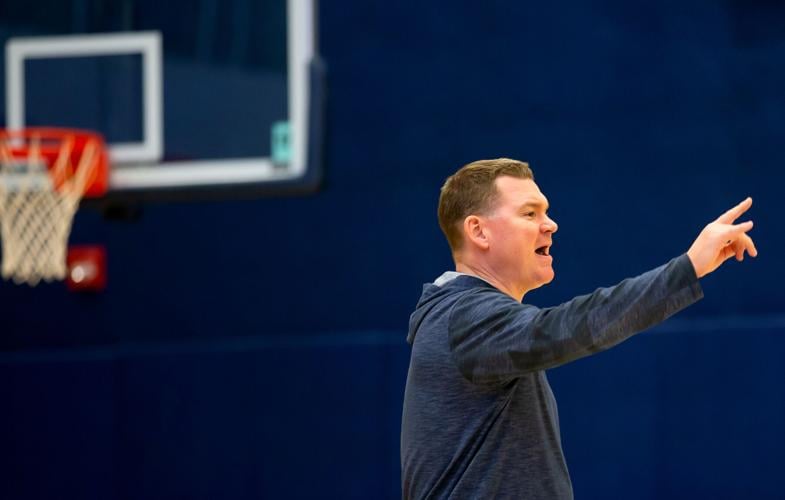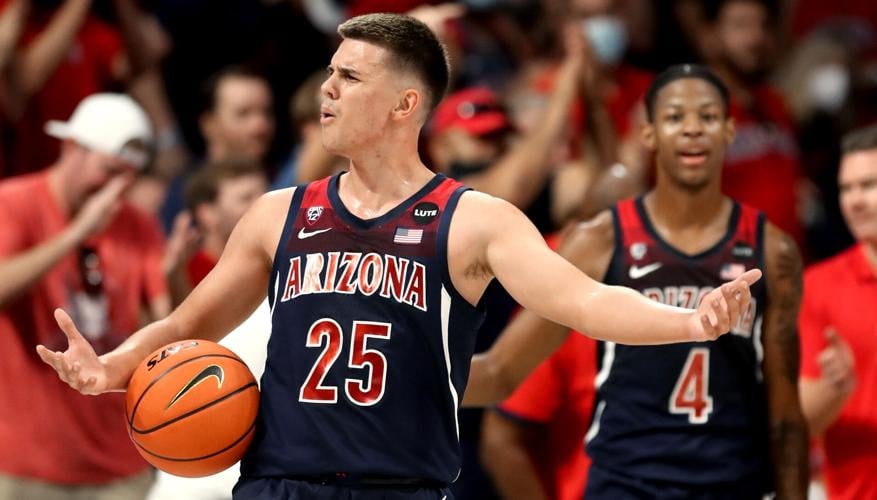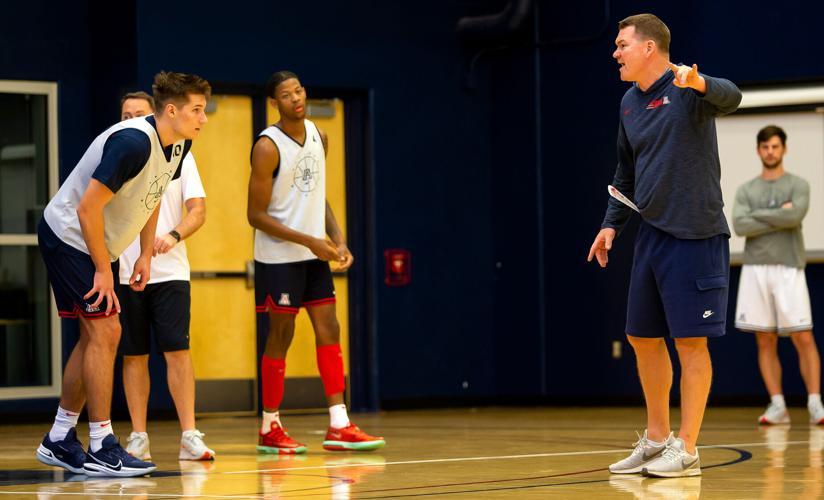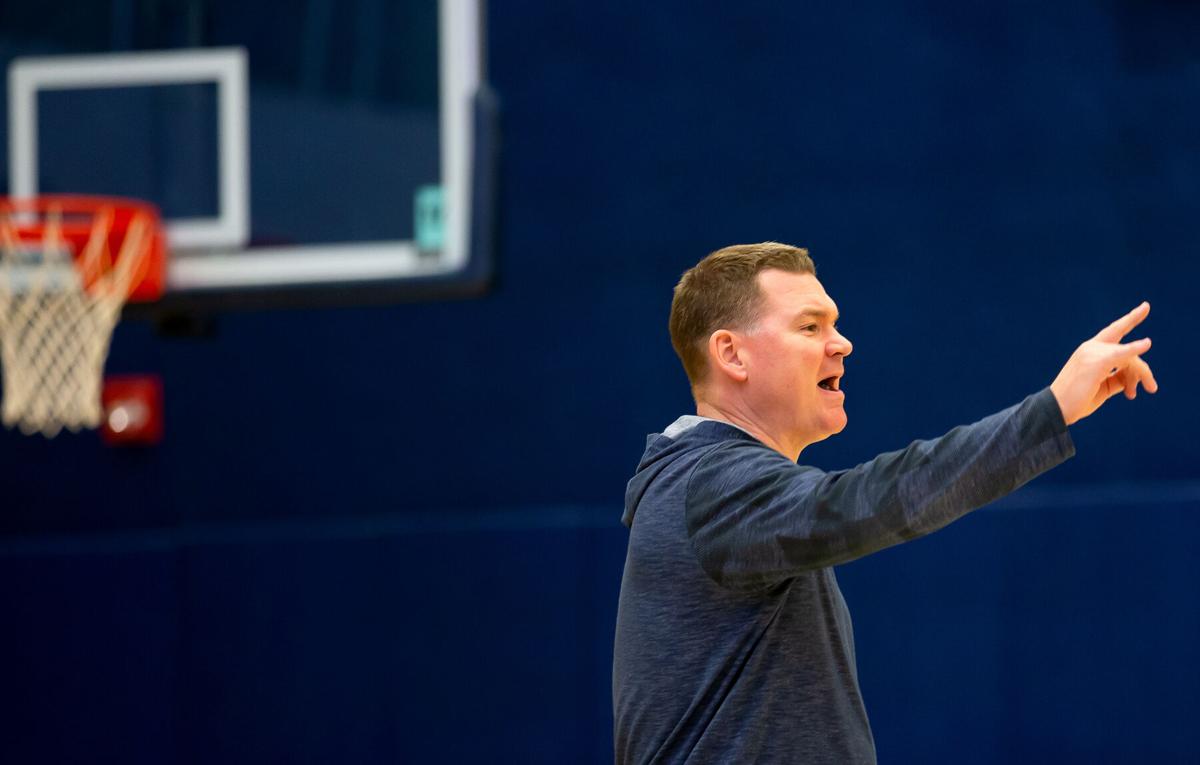There’s no way to tell exactly how good Tommy Lloyd’s first Arizona team will be.
Not only is the easygoing former Gonzaga assistant coach moving into the head coach’s chair for the first time in his life, but half of the Wildcats’ 12-player roster has flipped over. Lloyd must bring together players with different experience levels, backgrounds and ages.
The Wildcats have guys from eight different countries, including just as many who speak French (four) as English natively. Their ages range all the way from 17 (Adama Bal) to 23 (Justin Kier).
On the court, they have only one natural point guard (Kerr Kriisa) and three true big men (Azuolas Tubelis, Oumar Ballo and Christian Koloko), while their top returnees (Tubelis and Bennedict Mathurin) each have only 26 games of college experience.
Picked to finish in a tie for fourth place in the Pac-12 and among the top 30 vote-getters in the Associated Press preseason poll, the Wildcats could challenge for the conference title and maybe win a game or two in the NCAA Tournament. They might struggle against a rough early road schedule and never recover well enough to reach the postseason. Or something in between.
Who knows?
The only thing for sure is that the Wildcats will be faster. Maybe much faster.
While Arizona led the Pac-12 in scoring last season in the final episode of the Sean Miller era, averaging 75.4 points in conference games, the Wildcats actually operated with a below-average adjusted tempo. They ranked 198th out of 357 Division I teams in a Kenpom.com measure that speaks to the pace teams try to push regardless of how quick or slow their opponent is moving.
Lloyd’s Gonzaga team, meanwhile, ranked seventh in adjusted tempo. The Zags always run a faster-than-average tempo, with slight adjustments made in years when bigs such as Rui Hachimura or Przemek Karnowski emerge as dominant forces.
Having grown from an unpaid role all the way into to the top assistant for head coach Mark Few, Lloyd has consistently made it clear he wants the Wildcats to operate in the same way.
“I’d love to score in the 90s if possible, but I’ve never focused just on scoring,” Lloyd said. “For me, it’s all about tempo-pace, tempo-pace, to get easy possessions, easy shots. Once we get to half court, (there’s) ball movement, player movement. All you’re trying to do is get the best shot possible. Getting in transition is one of the best ways to do that. So I think you’re gonna see a real similar style of play that we had at Gonzaga.”
Except it’s not just as simple as it might look, not as simple as racing for the easy basket or, if it’s not there, improvising on the fly to find a better shot.
Here are some core tenets of that system, and how Lloyd’s new roster pieces might fit in.

Kerr Kriisa gestures to the crowd after the team wrapped up the Oct. 2 Red-Blue Game at McKale Center. Expect the second-year point guard to have major responsibilities in Tommy Lloyd’s new offense.
Keep moving
The funny thing is, Lloyd says, every player says they want to run “until they really have to run.” In other words, running for a high-possession, high-major team is a bit different than blasting downcourt for a tomahawk dunk in a pick-up game.
Running will be at the heart of everything the Wildcats will be doing, from the moment they gain possession of the ball — and even in the moments before they gain possession.
“You inbound it faster, you look to play shorter possessions, you’re looking for quicker, earlier shots,” says Arizona associate head coach Jack Murphy, who began his coaching career at UA under the similarly up-tempo-minded Lute Olson. “There’s a lot of different ways. Also defensively, you might play a little bit more (of an) aggressive style. It just all comes together in terms of tempo.”
Pushing a fast pace not only allows for the possibility of quick, easy shots but also can allow a team to dictate the terms of how things play out over the course of a full 40-minute game.
And even if that quick shot doesn’t open up, the Wildcats will still keep running.
“Once we get to half court, I love ball movement and player movement, players being able to create opportunities for themselves and their teammates based off of concepts, as opposed to running set plays,” Lloyd says. “And, hey, I love throwing the ball inside, too. So I think you’re gonna see all those things here.”
In previous seasons, if a good shot didn’t present itself in transition, Miller aimed to have the Wildcats make at least two or three passes in the halfcourt before a shot was taken.
There is no hard and fast rule anymore.
“You’re looking for great shots, you’re looking for sharing the basketball, finding the open man, playing fast, making the defense move,” Murphy says. “The best shot of a possession could come after the first pass, it could come after no passes. It could come after five. We’re coaching our guys to figure that out.”
Even for Kier, a “super senior” guard who was part of a Georgia team that ranked 13th in adjusted tempo last season, it’s something else. There are secondary actions and other wrinkles the Wildcats have embedded within their base offense, he said.
“I think this is a little bit more structured,” Kier said. “That’s a good thing. Last year we played really fast and aggressive, so now I’m learning to play fast and controlled.”
The two other players who are expected to handle the ball this season for the Wildcats might have a smoother adjustment.
Kriisa has already been playing in similar systems with a Lithuanian junior club and the Estonia national team, while Swedish combo guard Pelle Larsson transferred from Utah to Arizona after Lloyd was hired so he could play in a style he grew up preferring.
“Our system is very free-flowing,” Larsson said. “So I think (Lloyd) coaches us to be great players, not just great players in the system.”
Projected to start at shooting guard or at least play a major combo guard role, Larsson has been limited in the preseason because of a broken foot suffered while training with the Swedish national team in August. He could return for the Wildcats’ Nov. 9 opener against NAU.
That’s left Kriisa and Kier to spend much of the time as point guards in preseason practices.
“We’ve been going against each other a lot and we’re eager to play together,” Kier said. “But it’s great — I learned from him with his European game and I’m sure he learns a little bit from me from being in the SEC, controlling your strength a little bit, and stuff like that. So I pick up something from him and he picks up something from me. We’re here to help each other.”
Depend on ball screens, not sets
Of course, says former Wildcat standout and ESPN analyst Corey Williams, “every coach in existence” loves to use on-ball screens particularly as a strategy to free up a key guard or big man for an easier score.
But at Gonzaga, they’re an even bigger deal. The Zags have used a ball screen motion offense as a base, often starting a half-court effort with a ball screen, then having everyone else watch carefully how the defense — and their teammates — react. And then adjusting their own reactions.
Williams said he can’t speak for how Lloyd will run his offense at Arizona, but has seen this sort of structured flow for years while working Gonzaga games on ESPN channels.
For example, Williams says, a wing player might see a high-post ball screen, knowing that his big man will “dive” (cut toward the basket), and that he should get out of the lane and stand in the corner. Or a player might see his point guard coming up toward a high-post screen, and know he should run toward the point guard before making a back-door cut.
“These guys have these rules burned into their subconscious, so that when you and I sit down and watch the game, we’re like, ‘Man, they really move the ball. Look at the timing. Look at the spacing,’” Williams said. “I hate to say this, but they’re mindless zombies at that point. But that’s the intent. You drill these rules into their brain.”
That’s pretty much what Lloyd has been doing since the day he was hired as Arizona’s new coach last April.
“Tommy has broken down how to read a ball screen to the finest points,” Murphy said. “He has broken down, ‘When you’re passing it, this is how you should pass,’ and, ‘When you’re setting the screen, this is how you should set it.’ It’s actually really, really impressive.
“To go through each step, No. 1, would take forever. And No. 2, it would give away secrets. But, really, it’s been impressive.”
Williams, Murphy and former UA associate head coach Jim Rosborough all say Gonzaga’s system is a lot like the read-and-react motion offense that Olson operated. Williams added that it differed slightly in that Olson gave his best players even more freedom within it. The electric play of NBA-bound stars such as Damon Stoudamire, Jason Terry and Gilbert Arenas demanded he do so.
“This is not a slight against Gonzaga because they’ve sent a ton of guys to the NBA in recent years, but Coach Olson was willing to let his breakaway talent” go, Williams said. “We had a great offensive framework, and you were allowed to freestyle often as long as it resulted in something that was high percentage.
“If Damon wanted to go inside-out-crossover and hit a floater, we’re OK with that because he’s hitting 80% of his floaters. Or if Jason Terry dribbles through three guys, goes behind his back and dumps it off to A.J. (Bramlett, a 1990s-era UA center) for a dunk — yeah, there was a lot of relish on that hot dog, but we still ended up with a high percentage dunk from a big man.”
There were times in the late 1980s, Rosborough said, when Olson’s offense sometimes just called for star forward Sean Elliott to simply “take him,” to shred his defender.
After watching several of Lloyd’s practices this fall, Rosborough said he can see Lloyd adjusting to his players’ talents, too.
“They use a lot of ball screens and are very quick reacting offensively,” said Rosborough, now an assistant women’s basketball coach at Pima College. “But he’s got enough freedom in that his (Nos.) 2 and 3 men (wing players) can put it on the floor and get to the hole.
“Tommy’s going to give the kids freedom to use their abilities and the biggest thing that people are going to like is that it’s really going to be up-tempo. He’s going to let them get up and down the court.”
Share the love
En route to Pac-12 first team all-conference honors last season, point guard James Akinjo used about 60% of the on-ball screens Arizona set. In 2019-20, one-and-done freshman Nico Mannion did about the same.
But eventual NBA lottery pick Jalen Suggs utilized only about 30% of Gonzaga’s screens last season, and the Wildcats are now likely to set on-ball screens for a much wider distribution of beneficiaries.
That means it could be Kriisa much of the time, but also Larsson or Kier — or any of the Wildcats’ long, athletic wing players: Mathurin, sophomore Dalen Terry, and maybe even freshmen Shane Nowell and Adama Bal.
Gonzaga is “just much more spread out,” Murphy says. “For us, it’ll be Kerr. It’ll be Dalen Terry. It’ll be Benn Mathurin. It’ll be Pelle Larsson. They’re all getting an opportunity.”
The fundamentals come first, Lloyd said: how to move, how to move the ball, how to read what’s going on. Then adjustments can be made for individual talents.
“You have a base (offense) that you play, and within that you help guys either develop a skill set that allows them to be successful in that system, or you subtly adjust your system to allow guys to play to their strengths,” Lloyd said. “I’ve just been trying to make sure these guys understand how we want to play.”
A wider distribution of scoring could follow. So while Mathurin may come up with even more dominating performances like the 31 points he dropped on what became Oregon State’s Elite Eight team last season, he may not have to for the Wildcats to succeed.
Last season, Gonzaga’s top four scorers all averaged 12 points per game or more. Forward Drew Timme averaged 19, guard Corey Kispert averaged 18.6 and Suggs averaged 14.4. They were all stars on a given night, but all guys who could play complementary roles on others.
“Those individual egos really don’t take hold in a Mark Few program, because you came there to be a part of what they’ve already been doing,” Williams said. “It’s been explained to you how to play, what’s expected of you. At Arizona, I hate to say it — it’s a good problem to have — but we breed superstars. We breed first-round draft picks, guys that come in for some buckets and then go to the league. That’s a little bit different.”
While it could take several recruiting classes and coaching to develop a culture of selflessness throughout the roster, Lloyd believes his two top returning scorers, Mathurin and Tubelis, already have the mindset.
“Those guys are really talented and I expect them to be at the forefront of everything we do,” Lloyd said. “They’re also great team players. They’re not selfish. There will probably be days they dominate and probably days they blend in a little bit. But if the team’s playing well, that’s fine.”
Get offense from defense
While the Wildcats may not routinely lunge for steals in the manner of Lorenzo Romar’s Washington teams a decade ago, they are expected to become more aggressive defensively within their man-to-man defense.
That’s a slight change from their philosophy under Miller, who was known for a “pack-line” defense that emphasized keeping opponents out of the lane. Murphy, who coached under Miller after leaving NAU as a head coach in 2019, said it was “overblown” how different the pack-line was, but said the current Wildcats will probably extend farther out on the perimeter to defend. They also have the luxury of two 7-footers, Koloko and Ballo, sitting behind that perimeter.
“(What) this team has is somebody on the back side who can help fix mistakes in Christian Koloko,” he said. “Christian allows you to play a little more extended because if somebody gets beat, he will defend the rim.”
The Wildcats’ junior 7-footer from Cameroon is more versatile than that, too. Murphy said Koloko can defend in the halfcourt, switch on ball screens and guard players of varying size.
For the more physical matchups inside, there’s Ballo, the a 260-pound native of Mali who followed Lloyd from Gonzaga. And for those tricky matchups with hybrid forwards, the sort that caused UA problems against teams such as Oregon and UCLA last season, there’s 6-7 super senior transfer Kim Aiken, the Big Sky’s defensive player of the year last season.
Tubelis was mostly about offense last season while averaging 12.2 points and 7.1 rebounds per game as a freshman directly out of Lithuania. Lloyd said he’s worked to improve defensively — maybe to the point where he could handle guarding a center in a small-ball scheme.
UA’s backcourt is less proven defensively, though Kriisa showed an aggressive streak from the moment he first stepped on the court last season at Utah, having been forced to sit out the first 17 games of the season because of an NCAA ruling about arrangements that were made for him to play for a Lithuanian club.

Tommy Lloyd, left, discusses a defensive drill with forward Azuolas Tubelis, right, and fellow Wildcats during an Oct. 15 practice.
Keep the brain moving, too
While all this speed on both ends of the floor will test the Wildcats’ stamina, the structure within it will test their minds.
The ability to read and react offensively, and the ability to make sound snap decisions defensively, all require a high court intelligence.
While that, again, can take years of selective recruiting to fully install into a program, the Wildcats have several high-IQ players already on the roster. Even freshman wing Adama Bal, initially expected to require a redshirt year of development, has drawn praise from coaches for his ability to pick things up quickly. The similarly cerebral Koloko is getting a mental workout, too.
“Last year, we were passing the ball in the post and we have to score,” Koloko said. “Now, we can have the ball on the perimeter and you have to make plays and read the opposing team. That’s something we’ve been working on and something we’re going to do a lot this year.”
For Koloko and all the Wildcats, losing focus is not an option. Even for a second.
“Your basketball IQ to play for Mark Few, and I’m assuming to play for Tommy, has to be high,” Williams said. “There’s never a moment where you’re not paying attention to what’s going on with the ball, and that’s what gives coaches gray hairs.
“A lot of coaches try to build their program that way but, man, when you talk about the level of attention and detail that it takes to have five guys, sometimes seven or eight, who all know those roles and can react that way, that takes a lot. It takes a great coach and Mark Few is a great coach. It’s a very unselfish style of play.”
But for many of the Wildcats, it’s a familiar style of play. Williams said what he calls “ball position offense” is common in Europe, where he played as a pro for 12 years.
Five current Wildcats grew up in Europe, including the ever-confident Estonian point guard, Kriisa, and a soft-spoken Lithuanian in Tubelis, whose growing knowledge of English already allows him to sum up Tommy Lloyd and the 2021-22 Wildcats in a few simple sentences.
“We do a lot of new things in practices, because we have a good coach,” Tubelis said in typically measured but pointed words. “He likes to win. He comes to practices every time with a smile. He is a friendly person.
“So we just need to listen to him, share the ball, play fast, and we will be good.”







